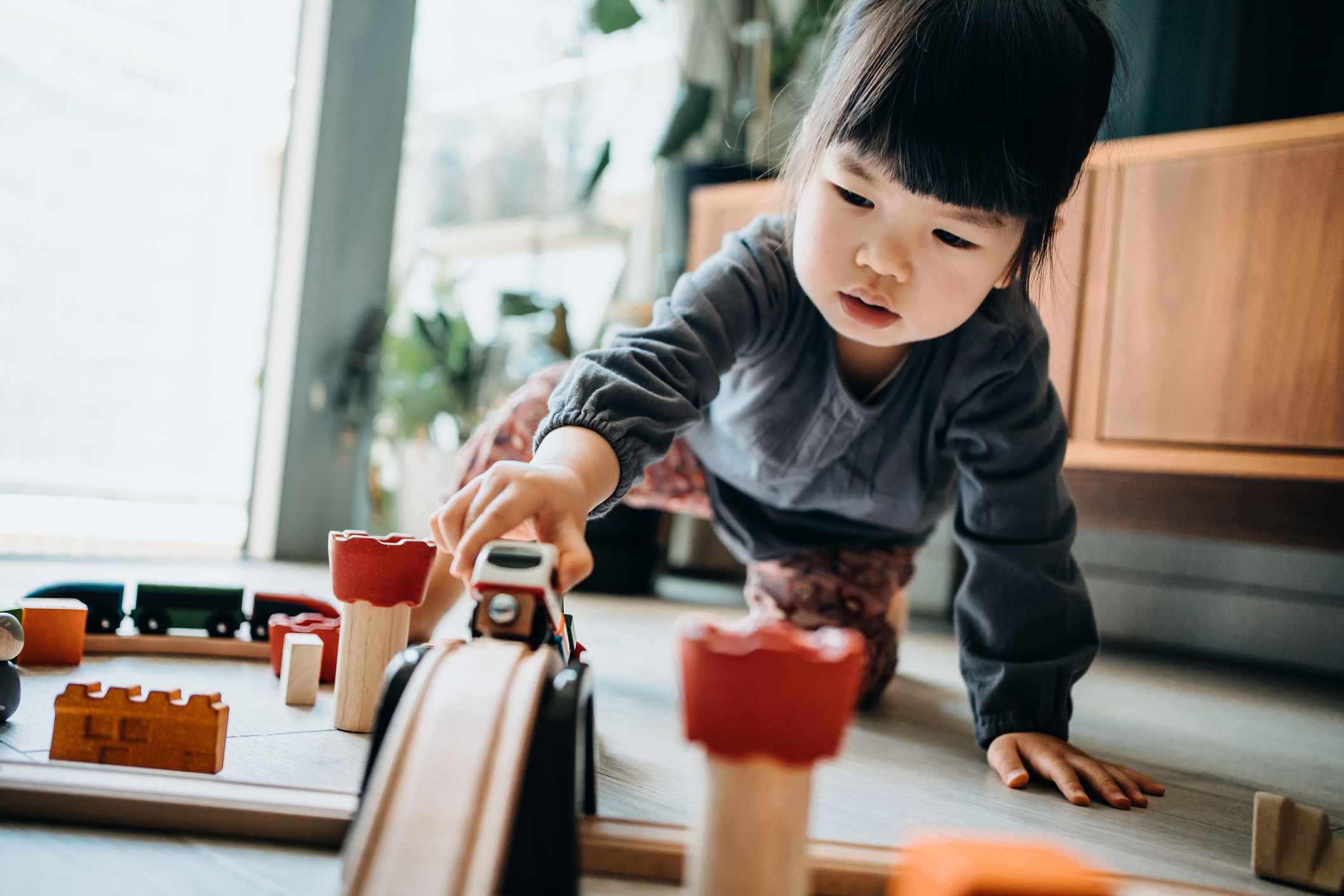What Is Play Therapy?
Play therapy is a form of psychotherapy and can be effective in helping children through emotional and mental issues.
Children often use play to express themselves and navigate the world and play therapy takes advantage of this. Play therapy is primarily used with children. Although, it can also be used with adults. It is typically used with children who are aged between 3 and 12.
The primary goal of play therapy is to help children who might struggle with expressing themselves or their emotions to express themselves through play.
A play therapist will guide a person through play therapy in a free and safe environment where they feel most comfortable expressing themselves. Play therapists use play activities a child might enjoy from painting to dancing to board games. At times play therapist will ask other family members or parents and guardians to also get involved in the playtime activities.
Types of Play Therapy
There are two main forms of play therapy used by play therapists:
- Directive Play Therapy: With directive play therapy, the therapist takes a hands-on approach and leads the child through guided play activities to help them express themselves. They’ll typically give specific instructions and supervise the child as they go through it.
- Non-directive Play Therapy: Non-directive play therapy makes use of a less controlled environment. The therapist leaves the child to engage in whatever play activities they might enjoy and express themselves with limited interference.
Techniques
Many different techniques can be applied during play therapy. The technique used during a therapy session largely depends on your child’s needs and what play mediums they feel most comfortable using.
A typical play therapy session usually lasts between 30 and 45 minutes. During a play therapy session, the therapist will create a comfortable and safe environment for the child to play. The therapist will then observe the child’s interactions with the toys that are provided.
As the child grows more comfortable in the therapist’s playroom, more specific play activities that target the issues the child is dealing with will be introduced. Some of the most common techniques used by play therapists across the world include:
- Using building blocks
- Using art
- Sand play
- Board games
- Play with dolls
- Puppet play
- Tea party play
- Card games
- Strategy games like chess or checkers
- Hide-and-seek
- LEGO play
What Play Therapy Can Help With
Play therapy is particularly beneficial for people who struggle with communicating and expressing themselves in a positive and healthy manner.
Children who have been abused or experienced extremely traumatic or stressful events might benefit from play therapy to regain a sense of normalcy in their lives. Children with certain disorders which hamper their emotional and social expressions typically benefit greatly from play therapy.
These could include children with behavioral disorders or learning disabilities. There has been some research into the effectiveness of play therapy on children with the following conditions:
Benefits of Play Therapy
People are often dismissive of play therapy and the benefits they hold. Concerned parents often find it hard to understand what benefits their children gain from “just playing.” However, the fact is that with or without the guidance of a therapist, children like to communicate through play, whether you might have noticed it or not.
A child playing violently with toys might be dismissed as aggressive when in reality, he might be mirroring a violent domestic situation he has been witnessing.
Here are some of the benefits of play therapy:
- Play therapy gives children who are having a hard time communicating verbally to express themselves through play activities. For instance, a child who refuses to speak might instead draw or paint out their thoughts or needs.
- It creates a space where a child will feel comfortable being themselves instead of other more traditional forms of psychotherapy.
- It allows the child to take charge of their therapy process. Effective play therapy allows the child to use toys and mediums they are most comfortable with and go at their own pace.
- It helps children understand their emotions, especially if they had struggled with doing this before.
- It helps children build up their communication and social skills with time. After several sessions, a child who wasn’t speaking might start to utter several phrases.
Effectiveness
Further research into the effectiveness of play therapy still needs to be carried out. Most traditional forms of therapy might not connect with children who are as young as 3 to 12 years old.
In a 2009 study on the effectiveness of play therapy with aggressive children, researchers divided a group of students with a history of aggressive behavior into two groups. One group was exposed to play therapy and the other group was used as a control group. At the end of the study, the researchers found that the children who had been exposed to play therapy showed significant improvement in aggressive behaviors over the children in the control group.
A 2005 analysis of 93 studies conducted between 1953 to 2000 on the effectiveness of play therapy with children also supports the theory that it’s an effective method of therapy for children. The review found that this form of therapy produced positive effects, even more so when the parents of the child in therapy were involved. It also found that this form of therapy appeared to be effective across age and gender.
Things to Consider
While a play therapist will take the lead during play therapy, the child’s parent or guardian also has an important role to play.
The play therapist will typically have a joint consultation with the parent and guardian and the child and also separate consultations with all parties involves. This is done to completely understand the child’s needs. When looking for a play therapist for your child, it’s important to ensure they have the relevant experience and expertise.
How to Get Started
If you have a child who might benefit from play therapy or know someone who could you should get started by getting in touch with a licensed psychologist or psychotherapist who has expereience dealing with children, and with play therapy. Play therapy is typically done over several sessions, it’s also important to work with someone with who your child feels absolutely comfortable.
What is play therapy?
Play therapy is a form of therapy used primarily for children. That’s because children may not be able to process their own emotions or articulate problems to parents or other adults.
While it may look like an ordinary playtime, play therapy can be much more than that.
A trained therapist can use playtime to observe and gain insights into a child’s problems. The therapist can then help the child explore emotions and deal with unresolved trauma. Through play, children can learn new coping mechanisms and how to redirect inappropriate behaviors.
Play therapy is practiced by a variety of licensed mental health professionals, like psychologists and psychiatrists. It’s also practiced by behavioral and occupational therapists, physical therapists, and social workers.
In addition, the Association for Play Therapy offers specialized training programs and advanced credentials for licensed mental health professionals, school counselors, and school psychologists.
Benefits of play therapy
According to the professional organization Play Therapy International, up to 71 percent of children referred to play therapy may experience positive change.
While some children might start off with some hesitation, trust in the therapist tends to grow. As they become more comfortable and their bond strengthens, the child may become more creative or more verbal in their play.
Some of the potential benefits of play therapy are:
- taking more responsibility for certain behaviors
- developing coping strategies and creative problem-solving skills
- self-respect
- empathy and respect for others
- alleviation of anxiety
- learning to fully experience and express feelings
- stronger social skills
- stronger family relationships
Play therapy can also encourage use of language or improve fine and gross motor skills.
If your child has a diagnosed mental or physical illness, play therapy doesn’t replace medications or any other necessary treatments. Play therapy can be used alone or alongside other therapies.
How does play therapy work?
There’s a bit of a communication gap between children and adults. Depending on age and stage of development, children simply don’t have the language skills of adults. They may feel something, but in many cases, they either can’t express it to an adult or don’t have a trusted adult to express it to.
On the other end, adults can misinterpret or completely miss the child’s verbal and nonverbal cues.
Children learn to understand the world and their place in it through play. It’s where they’re free to act out their inner feelings and deepest emotions. Toys can act as symbols and take on greater meaning — if you know what to look for.
Since the child can’t adequately express themselves in the adult world, the therapist joins the child in their world, on their level.
As they play, the child may become less guarded and more apt to share their feelings. But they aren’t pressured. They’re allowed to do so in their own time and with their own method of communication.
Play therapy will differ depending on the therapist and the particular needs of the child. To begin, the therapist may want to observe the child at play. They may also want to conduct separate interviews with the child, parents, or teachers.
After a thorough assessment, the therapist will set some therapeutic goals, decide on what limits may be necessary, and formulate a plan for how to proceed.
Play therapists pay close attention to how a child handles being separated from the parent, how they play alone, and how they react when the parent returns.
Much can be revealed in how a child interacts with different types of toys and how their behavior changes from session to session. They may use play to act out fears and anxieties, as a soothing mechanism, or to heal and problem-solve.
Play therapists use these observations as a guide to the next steps. Each child is different, so therapy will be tailored to their individual needs. As therapy progresses, behaviors and goals can be reassessed.
At some point, the therapist may bring parents, siblings, or other family members into play therapy. This is known as filial therapy. It can help teach conflict resolution, promote healing, and improve family dynamics.
Play therapy techniques
Sessions typically last 30 minutes to an hour and are held once a week or so. How many sessions are needed depends on the child and how well they respond to this type of therapy. Therapy can take place individually or in groups.
Play therapy can be directive or nondirective. In the directive approach, the therapist will take the lead by specifying the toys or games that’ll be used in the session. The therapist will guide the play with a specific goal in mind.
The nondirective approach is less structured. The child is able to choose toys and games as they see fit. They’re free to play in their own way with few instructions or interruptions. The therapist will observe closely and participate as appropriate.
Sessions must take place in an environment where the child feels safe and where there are few limitations. The therapist may use techniques that involve:
- creative visualization
- storytelling
- role-playing
- toy phones
- puppets, stuffed animals, and masks
- dolls, action figures
- arts and crafts
- water and sand play
- blocks and construction toys
- dance and creative movement
- musical play
Examples of play therapy
Depending on the child and the situation, the therapist will either guide the child toward certain methods of play or let them choose for themselves. There are any number of ways the therapist can use play therapy to get to know the child and help them cope with their problems.
For example, the therapist might offer the child a dollhouse and some dolls, asking them to act out some problems they have at home. Or they might encourage the child to use hand puppets to recreate something they found stressful or frightening.
They might ask your child to tell a “once upon a time” story to see what the child might bring to light. Or they might read stories that solve a problem similar to your child’s. This is referred to as bibliotherapy.
It could be as simple as asking questions while your child is drawing or painting to try to gain insights into their thought process. Or play various games with the child to encourage problem-solving, cooperation, and social skills.
Play therapy for adults
Play isn’t just for kids, and neither is play therapy. Teenagers and adults can also have a difficult time expressing their innermost feelings in words. Adults who may benefit from play therapy include those affected by:
- intellectual disabilities
- dementia
- chronic illness, palliative care, and hospice care
- substance use
- trauma and physical abuse
- anger management issues
- post-traumatic stress disorder (PTSD)
- unresolved childhood issues
When working with adults, a therapist may use dramatic role-playing or sand-tray therapy to help you get in touch with feelings that are hard to talk about. These therapies can help you work on strategies for dealing with particular scenarios.
The very act of playing, whether it’s games, arts and crafts, or music and dance, can help you relax and unwind from the stresses of everyday life.
Art therapy, music therapy, and movement can help reveal hidden traumas and promote healing. Under the guidance of an experienced therapist, play can be a valuable tool in getting you where you want to be.
Play therapy for adults may be used as a complement to other types of therapy and medications. As with children, the therapist will tailor play therapy to your specific needs.
Takeaway
Play therapy is a method of therapy that uses play to uncover and deal with psychological issues. It can be used on its own, particularly with children, or along with other therapies and medications.
To get the most out of play therapy, look for a licensed mental health professional experienced in this type of therapy. Your pediatrician or primary care doctor can make a referral.
If you don’t already have a mental health professional, the Healthline FindCare tool can help you find one in your area.
You may also choose to search for a credentialed registered play therapist (RPT) or registered play therapist-supervisor (RPT-S) through the Association for Play Therapy.




